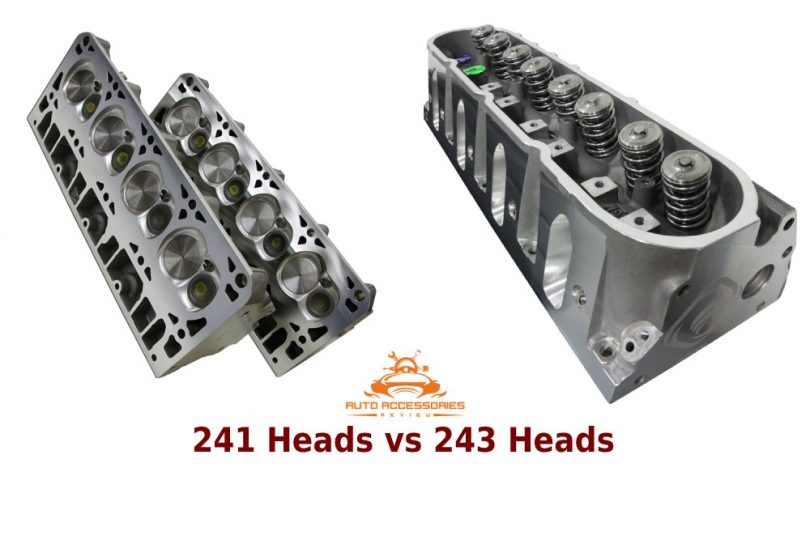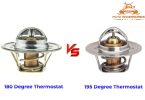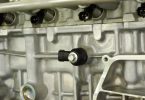There are three main differences between 241 and 243 heads. The first is the size of the combustion chamber, the 241 has a 67 cc, and the 243 has a 65 cc.
The second is the port shapes. The 241’s oval-shaped port has a 200 cfm intake, and the port on the 243 is D-shaped and offers better flow.
The last difference is the hollow, sodium-filled valve stem that provides improved heat transfer between the heads and exhaust, reducing the valve train inertia while running.
However, there’s more to it. Let’s dig deeper and see how exactly they differ!
A brief explanation of the heads
You may hear mechanics refer to the top of the engine block as the heads. The head – also called the cylinder head – houses the intake and outtake valves, lifters, combustion chamber, and springs. It allows air to flow through its passages to let fuel enter the cylinder and exhaust gases outflow.
The passages (often called tracts or ports) create the channel for coolant to enter the engine block and cool down engine components. Head gaskets in the combustion chamber stop water and oil from entering these combustion chambers.
OEM heads made of cast iron are very heavy and add weight to the vehicle. However, cast iron also holds heat. The 241 and 234 are made from lightweight aluminum and are found in performance cars. V engines have double heads, and inline engines have a single cylinder head.
Cylinders with individual heads found on bigger industrial automotive offset the cost of replacing the heads.
241 heads
Pros
- Aluminum build prevents rust
- 241 is the lighter of the two
- Output of 345 hp
Cons
- Expensive parts
- Replacement parts are hard to get
- Oil system issues affect piston ring seals
- Engine blow-by can be an issue
243 heads
Pros
- Powerful aluminum head
- Lightweight engine
- 405 hp output
Cons
- Parts are more costly than the 241
- The best value between the two heads
- Piston ring seal issues
- Not fixing the piston ring issue will affect other systems
241 vs 243 Heads: How Do They Differ?
1. Cubic centimeters
-
241 heads
The 67cc combustion chamber on a 241 head means a compression decrease of about 0.70 points.
-
243 heads
The 243 head is smaller at 65 ccs but offers more compression.
-
Winner
The clear winner here is the 243 head with its increased compression.
2. Intake valve
-
241 heads
The intake valve on a 241 head is a 2.00.
-
243 heads
The 243 head’s intake valve is 2.00
-
Winner
Both heads offer an intake valve of 2.00, making this race a tie.
3. Exhaust valve
-
241 heads
The exhaust valve on a 241 is 1.55.
-
243 heads
The exhaust valve on a 243 is 1.55.
-
Winner
It is a tie since both heads have an exhaust head of 1.55.
4. Intake Peak Flow
-
241 heads
An intake peak flow of 302 is provided by the 241 head.
-
243 heads
The 243 offers a peak flow of 250 cubic feet per minute (cfm).
-
Winner
The 243 wins because it offers the highest peak flow at 250 cfm.
5. Exhaust Peak Flow
-
241 heads
It offers an exhaust peak flow of 240.
-
243 heads
It has the lowest exhaust peak flow at 191 cfm.
-
Winner
The 241 head with its exhaust peak flow of 240 is the clear winner.
6. Springs
-
241 heads
The springs on a 241 are FED .660 Dual LSX with titanium retainers.
-
243 heads
The 243 head also has a FED .660 Dual LSX with titanium retainers.
-
Winner
Both heads have the same spring, so we again have a tie.
7. Cost
-
241 heads
A fully assembled 241 head price is around $6300 fully assembled.
-
243 heads
A fully assembled 243 head retails at about $4500.
-
Winner
Picking a winner is near impossible when considering the cost of a fully assembled 241 or 243 heads because it depends on the vehicle you are putting them in.
How to keep the cylinder head working well?
Coolant is the lifeblood of the engine. Unfortunately, it is also the one thing people check the least. Dirty coolant and low coolant levels can lead to a blown cylinder head gasket.
You should check coolant levels weekly to bi-weekly, especially when your engine runs hotter in the summer. You can check it by locating the coolant reservoir in front of your engine.
There is a max fill line for the coolant level. You are good to go if the coolant is at the max fill level. If it is below the fill line, top off the reservoir to the fill line, close the cap, and you are ready to run.
FAQs
1. Can I upgrade to 243 heads if I have 241 heads?
Ans. You can keep the 241s unless you want more power. If you switch the heads out to increase your power, you‘ll get the results you’re looking for, and your foundation will be stronger. The outcome is pretty much the same.
The 241 heads are dependable, so leave them in, but you should match the gasket and bowl blend for the extra 10 cfm you would get if you ran the 243s.
2. What makes 243 heads exceptional?
Ans. The 243’s hollow stem valve withstands more turbo and supercharger applications because it gives a better RPM potential. You get 5% more flow with the 243s.
3. How much more HP does a 243 head offer?
Ans. The 243 offers 25 horsepower because of the compression ratio and can increase the power output by 3 to 4 percent. Credit, the 243’s cathedral, shaped intake port with its smaller chambers for the increase.










Leave a Comment